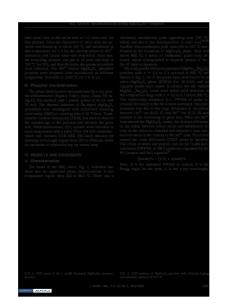Multicolor Luminescence from Ca 3 Y 2 (SiO 4 ) 3 :Eu 2 +,Eu 3 + Material
- PDF / 259,340 Bytes
- 6 Pages / 432 x 648 pts Page_size
- 81 Downloads / 372 Views
Multicolor Luminescence from Ca3Y2(SiO4)3:Eu2+,Eu3+ Material Anna Dobrowolska and Eugeniusz Zych Faculty of Chemistry, University of Wroclaw 14 F. Joliot-Curie Street 50-383 Wroclaw, Poland ABSTRACT Ca3Y2(SiO4)3 powder activated with Eu was prepared with ceramic method. Its spectroscopic properties in VUV-UV-Vis region together with structure and morphology were analyzed. Luminescence measurements indicated that Ca3Y2(SiO4)3 prepared in a reducing atmosphere contained both Eu2+ and Eu3+ ions. The excitation could be tuned to generate a complex luminescence consisting of a broad band related to a blue-greenish 5d 2+
Eu and 4f
4f emission of
3+
4f red luminescence of Eu . Their superposition covered the whole visible part
of spectrum and appeared almost white among others upon excitation around 390 nm. INTRODUCTION Light emitting diodes (LEDs) are one of the most rapidly evolving branches of the solid state lighting technology in recent years. Special interest is devoted to white LEDs due to their high brightness and efficiency, long lifetime and low power consumption [1]. To make white LEDs, blue or UV emitting LEDs are combined with phosphor(s) able to convert the radiation of a semiconductor chip into longer-wavelengths visible light [2, 3, 4]. Blue and UV-LEDs require different phosphors. Especially for the latter a mixture of phosphors is usually needed to cover with their luminescence possibly entire range of the visible part of spectrum. Our goal is to design a single phosphor efficiently stimulated with a near UV-LED (340-400 nm) and able to produce white light with spectral characteristics similar to the natural sunlight. At first, to make such a material we explored Ca3Y2(SiO4)3 host doped with two different europium ions, Eu2+ and Eu3+. We considered this host attractive as it offers metal sites of both +2 (Ca) and +3 (Y) charges. We anticipated that europium, under favorable conditions of the material fabrication, should tend to enter the host as to distinct luminescent centers: a broad band emitting Eu2+, whose 5d ĺ 4f luminescence might well locate in blue-green part of spectrum, and Eu3+ which
55
sends off red photons due to the 4f ĺ 4f transitions. Till now this lattice was explored as a host for trivalent lanthanides only [5, 6, 7, 8]. We shall present preliminary results on luminescent spectroscopy of the Ca3Y2(SiO4)3:Eu2+,Eu3+ phosphor and will demonstrate that introducing only one element as a dopant (Eu) and applying precisely defined synthesis conditions may be enough to get efficient white light emitting phosphor. EXPERIMENT Eu-doped calcium yttrium silicate, Ca3Y2(SiO4)3, was synthesized with the classic ceramic method calcining a mixture of CaO (99.6-100.5 %), Y2O3 and (99.99 %), SiO2 (AR) and Eu2O3 (99.99 %) powders. Eu was assumed to substitute Y3+ exclusively giving Ca3Y2(1x)Eu2x(SiO4)3,
where x= 0.01. The substrates were thoroughly ground. After drying the mixture
was heated twice in the reducing atmosphere of H2 (25 %)-N2 (75%) mixture at 1400 °C for 6 h with an intermediate gri
Data Loading...











